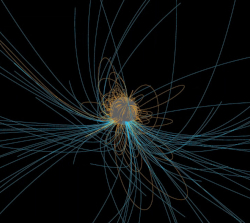 HEAPOW: Mapping a Neutron Star (2019 Dec 16)
HEAPOW: Mapping a Neutron Star (2019 Dec 16)
Neutron stars are tiny objects with extremely high densities created when a star at least eight times more massive then the sun dies. The dying star first collapses, and the region near the very center of the star gets crushed by the enormous weight of the rest of the star. The central region of the star is squeezed so much that all the protons and electrons in the atoms are forced together to form neutrons, so that this dense, compact region is called a neutron star. A neutron star is therefore fundamentally an enormous atomic nucleus in space, one that's about a million trillion times larger than an ordinary atomic nucleus. These bizarre objects offer scientists the means to study the peculiar way that matter behaves at extreme densities, revealing physical secrets impossible to obtain in a terrestrial laboratory. Hot regions near the magnetic poles of the neutron star generate pulses of X-ray radiation as the neutron star spins, so X-ray emission is a good way to study neutron stars. Because neutron stars are so dense, they warp spacetime around them. The curved spacetime near a neutron star changes the way the pulses of X-rays from the magnetic poles vary with time. By carefully studying the time variation of a neutron star's X-ray pulses, astronomers can in principle determine how much the spacetime around the neutron star is bent, and thus measure the neutron star's density. The Neutron Star Interior Composition Explorer (or NICER for short) is an X-ray observatory on the International Space Station whose main goal is to precisely study the X-ray variations from rotating neutron stars, and to use these variations to measure the star's density. And now, for the first time, NICER has successfully measured the density of a neutron star called J0030+0451. Through very careful analysis of the X-ray variations from this neutron star, the NICER data show that J0030+0451 is 40 percent more massive than the Sun, but only about 15 miles wide. This means that J0030+0451 has a density about 100 trillion times the density of water, so that one teaspoon of J0030+0451 material would contain as much mass as the combined mass of all 8 billion people on earth. The NICER observations have also overturned the simple picture scientists have had of the shape of the neutron star's magnetic field. For decades, scientists assumed that neutron stars had simple dipolar magnetic fields, similar to the shape of the earth's magnetic field, with a one north pole and one south pole in opposite hemispheres. NICER shows that the shape of the magnetic field of J0030+0451 is much more complicated, with at least two poles in the same hemisphere. A visualization of what the complicated magnetic morphology of J0030+0451 might look like is shown above. Start re-writing those textbooks!
GSFC: NICER Delivers Best-ever Pulsar Measurements, 1st Surface Map
| << Previous HEAPOW | High Energy Astrophysics Picture of the Week | Next HEAPOW >> |